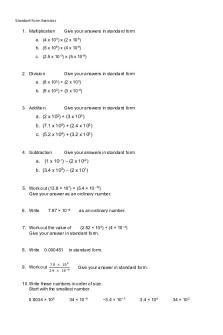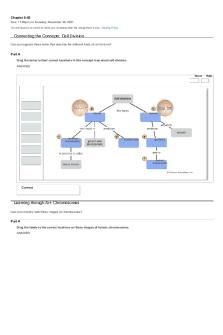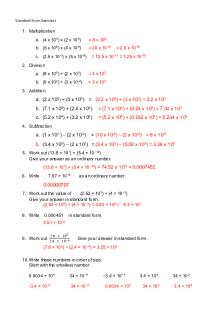Preoperative questions form Pearson PDF

| Title | Preoperative questions form Pearson |
|---|---|
| Course | Nursing Research |
| Institution | University of the District of Columbia |
| Pages | 41 |
| File Size | 247.2 KB |
| File Type | |
| Total Downloads | 54 |
| Total Views | 157 |
Summary
Lecture Notes....
Description
Nursing: A Concept-Based Approach to Learning Vol. 1 & 2, 3e (Pearson) Module 17 Perioperative Care
The Concept of Perioperative Care
1) The nurse is providing teaching to a client who is scheduled to undergo surgery in 2 weeks. Which topics should the nurse include that will prepare the client to help reduce complications during the postoperative phase? Select all that apply. A) Maintaining a patent airway B) Deep breathing and coughing C) Caring for the surgical incision D) Managing constipation E) Managing pain Answer: B, C, D, E Explanation: A) Maintaining a patent airway is a nursing action that is performed during and after surgery; the client would not need client teaching about how to maintain a patent airway. In the preoperative phase, when the client is alert and oriented, the nurse should focus teaching on deep breathing and coughing exercises, care of the surgical incision, managing constipation, and managing pain. This knowledge will help the client reduce complications after the surgery. B) Maintaining a patent airway is a nursing action that is performed during and after surgery; the client would not need client teaching about how to maintain a patent airway. In the preoperative phase, when the client is alert and oriented, the nurse should focus teaching on deep breathing and coughing exercises, care of the surgical incision, managing constipation, and managing pain. This knowledge will help the client reduce complications after the surgery. C) Maintaining a patent airway is a nursing action that is performed during and after surgery; the client would not need client teaching about how to maintain a patent airway. In the preoperative phase, when the client is alert and oriented, the nurse should focus teaching on deep breathing and coughing exercises, care of the surgical incision, managing constipation, and managing pain. This knowledge will help the client reduce complications after the surgery. D) Maintaining a patent airway is a nursing action that is performed during and after surgery; the client would not need client teaching about how to maintain a patent airway. In the preoperative phase, when the client is alert and oriented, the nurse should focus teaching on deep breathing 1 Copyright © 2019 Pearson Education, Inc.
and coughing exercises, care of the surgical incision, managing constipation, and managing pain. This knowledge will help the client reduce complications after the surgery.
2 Copyright © 2019 Pearson Education, Inc.
E) Maintaining a patent airway is a nursing action that is performed during and after surgery; the client would not need client teaching about how to maintain a patent airway. In the preoperative phase, when the client is alert and oriented, the nurse should focus teaching on deep breathing and coughing exercises, care of the surgical incision, managing constipation, and managing pain. This knowledge will help the client reduce complications after the surgery. Page Ref: 1354 Cognitive Level: Applying Client Need/Sub: Health Promotion and Maintenance Standards: QSEN Competencies: III.A.1. Demonstrate knowledge of basic scientific methods and processes. | AACN Essential Competencies: IX.3. Implement holistic, patient-centered care that reflects an understanding of human growth and development, pathophysiology, pharmacology, medical management and nursing management across the health-illness continuum, across lifespan, and in all healthcare settings. | NLN Competencies: Knowledge and Science: Relationships between knowledge/science and quality and safe patient care. | Nursing Process: Planning Learning Outcome: 17.3 Explain the process of preoperative nursing. MNL LO: Analyze the concept of perioperative care and its application to nursing care.
3 Copyright © 2019 Pearson Education, Inc.
2) The nurse is providing teaching to a client who is about to undergo surgery. When discussing whom the client can expect to see in the operating room suite, which individuals should the nurse include? Select all that apply. A) Surgeon B) Postoperative nurse C) Circulating nurse D) Anesthesiologist E) Social worker Answer: A, C, D
4 Copyright © 2019 Pearson Education, Inc.
Explanation: A) The surgeon performs the procedure. The postoperative nurse will provide care to the client after the surgery is completed. The circulating nurse is a perioperative registered nurse who cares for the client during the surgical procedure. The anesthesiologist provides the anesthesia during the surgery and continually monitors the client's physiologic status. The social worker will not be in attendance during the procedure but may become involved in the client's care during the preoperative and postoperative phases. B) The surgeon performs the procedure. The postoperative nurse will provide care to the client after the surgery is completed. The circulating nurse is a perioperative registered nurse who cares for the client during the surgical procedure. The anesthesiologist provides the anesthesia during the surgery and continually monitors the client's physiologic status. The social worker will not be in attendance during the procedure but may become involved in the client's care during the preoperative and postoperative phases. C) The surgeon performs the procedure. The postoperative nurse will provide care to the client after the surgery is completed. The circulating nurse is a perioperative registered nurse who cares for the client during the surgical procedure. The anesthesiologist provides the anesthesia during the surgery and continually monitors the client's physiologic status. The social worker will not be in attendance during the procedure but may become involved in the client's care during the preoperative and postoperative phases. D) The surgeon performs the procedure. The postoperative nurse will provide care to the client after the surgery is completed. The circulating nurse is a perioperative registered nurse who cares for the client during the surgical procedure. The anesthesiologist provides the anesthesia during the surgery and continually monitors the client's physiologic status. The social worker will not be in attendance during the procedure but may become involved in the client's care during the preoperative and postoperative phases. E) The surgeon performs the procedure. The postoperative nurse will provide care to the client after the surgery is completed. The circulating nurse is a perioperative registered nurse who cares for the client during the surgical procedure. The anesthesiologist provides the anesthesia during the surgery and continually monitors the client's physiologic status. The social worker will not be in attendance during the procedure but may become involved in the client's care during the preoperative and postoperative phases. Page Ref: 1348 Cognitive Level: Analyzing Client Need/Sub: Safe and Effective Care Environment: Management of Care Standards: QSEN Competencies: II.A.2 Describe scopes of practice and roles of health care team members. | AACN Essential Competencies: VI.1 Compare/contrast the roles and perspectives of the nursing profession with other care professionals on the healthcare team (i.e. scope of discipline, education and licensure requirements). | NLN Competencies: Knowledge and 5 Copyright © 2019 Pearson Education, Inc.
Science: Relationships between knowledge/science and quality and safe patient care. | Nursing Process: Implementation Learning Outcome: 17.1 Summarize the scope of perioperative nursing. MNL LO: Analyze the concept of perioperative care and its application to nursing care.
6 Copyright © 2019 Pearson Education, Inc.
3) The postoperative nurse is planning care for a client recovering from major thoracic surgery. Which nursing diagnoses should the nurse select to plan for this client's immediate care needs? Select all that apply. A) Risk for Impaired Gas Exchange B) Risk for Decreased Cardiac Output C) Deficient Knowledge D) Risk for Imbalanced Nutrition: Less than Body Requirements E) Risk for Imbalanced Fluid Volume Answer: A, B, E
7 Copyright © 2019 Pearson Education, Inc.
Explanation: A) Nursing diagnoses appropriate for the immediate postoperative phase include the Risk for Impaired Gas Exchange because of anesthesia medications and hypothermia, the Risk for Decreased Cardiac Output because of anesthesia, and the Risk for Imbalanced Fluid Volume because of blood loss and nothing by mouth status. Deficient Knowledge is a diagnosis more appropriate to the preoperative phase before surgery. There is no Risk for Imbalanced Nutrition: Less than Body Requirements during the immediate postoperative phase. B) Nursing diagnoses appropriate for the immediate postoperative phase include the Risk for Impaired Gas Exchange because of anesthesia medications and hypothermia, the Risk for Decreased Cardiac Output because of anesthesia, and the Risk for Imbalanced Fluid Volume because of blood loss and nothing by mouth status. Deficient Knowledge is a diagnosis more appropriate to the preoperative phase before surgery. There is no Risk for Imbalanced Nutrition: Less than Body Requirements during the immediate postoperative phase. C) Nursing diagnoses appropriate for the immediate postoperative phase include the Risk for Impaired Gas Exchange because of anesthesia medications and hypothermia, the Risk for Decreased Cardiac Output because of anesthesia, and the Risk for Imbalanced Fluid Volume because of blood loss and nothing by mouth status. Deficient Knowledge is a diagnosis more appropriate to the preoperative phase before surgery. There is no Risk for Imbalanced Nutrition: Less than Body Requirements during the immediate postoperative phase. D) Nursing diagnoses appropriate for the immediate postoperative phase include the Risk for Impaired Gas Exchange because of anesthesia medications and hypothermia, the Risk for Decreased Cardiac Output because of anesthesia, and the Risk for Imbalanced Fluid Volume because of blood loss and nothing by mouth status. Deficient Knowledge is a diagnosis more appropriate to the preoperative phase before surgery. There is no Risk for Imbalanced Nutrition: Less than Body Requirements during the immediate postoperative phase. E) Nursing diagnoses appropriate for the immediate postoperative phase include the Risk for Impaired Gas Exchange because of anesthesia medications and hypothermia, the Risk for Decreased Cardiac Output because of anesthesia, and the Risk for Imbalanced Fluid Volume because of blood loss and nothing by mouth status. Deficient Knowledge is a diagnosis more appropriate to the preoperative phase before surgery. There is no Risk for Imbalanced Nutrition: Less than Body Requirements during the immediate postoperative phase. Page Ref: 1371 Cognitive Level: Analyzing Client Need/Sub: Physiological Integrity: Physiological Adaptation Standards: QSEN Competencies: I.A.1. Integrate understanding of multiple dimensions of patient-centered care: Patient/family/community preferences, values; Coordination and integration of care; Information, communication, and education; Physical comfort and emotional support; Involvement of family and friends Transition and continuity. | AACN Essential 8 Copyright © 2019 Pearson Education, Inc.
Competencies: IX.7. Provide appropriate patient teaching that reflects developmental state, age, culture, spirituality, patient preferences, and health literacy considerations to foster patient engagement in their care. | NLN Competencies: Relationship Centered Care: Effective communication. | Nursing Process: Evaluation Learning Outcome: 17.5 Explain the process of postoperative nursing. MNL LO: Analyze the concept of perioperative care and its application to nursing care.
9 Copyright © 2019 Pearson Education, Inc.
4) The postoperative recovery room nurse determines that a client in the postoperative phase of care can be transitioned to phase 2 of recovery. The client is able to take deep breaths and cough, is using oxygen to maintain a saturation of greater than 90%, is fully awake, has a systolic blood pressure that is 130 mmHg now but the preoperative systolic blood pressure was 100 mmHg, and is able to move all four extremities independently. Using the following scale, this client's Aldrete score is ________. The Aldrete score:
Respiration 2 = Able to take deep breath and cough 1 = Dyspnea/shallow breathing 0 = Apnea
O2 Saturation 2 = Maintains >92% on room air 1 = Needs O2 inhalation to maintain O2 saturation >90% 0 = Saturation...
Similar Free PDFs

Preoperative questions form Pearson
- 41 Pages

Ch 8 Pearson HW Questions
- 7 Pages

P141 - Pearson
- 1 Pages

Preoperative checklist FS
- 2 Pages

Standard Form Questions - Week 3
- 4 Pages

TR1 Form - TR1 Form
- 4 Pages

AP1 Form - AP1 Form
- 7 Pages

2020-Bio-Form-v1 0 - questions
- 10 Pages

Chapter 8-02 - Pearson - Homework
- 22 Pages

Chapter 8-01 - Pearson - Homework
- 15 Pages

Intrapartum Care Skills PEARSON
- 6 Pages
Popular Institutions
- Tinajero National High School - Annex
- Politeknik Caltex Riau
- Yokohama City University
- SGT University
- University of Al-Qadisiyah
- Divine Word College of Vigan
- Techniek College Rotterdam
- Universidade de Santiago
- Universiti Teknologi MARA Cawangan Johor Kampus Pasir Gudang
- Poltekkes Kemenkes Yogyakarta
- Baguio City National High School
- Colegio san marcos
- preparatoria uno
- Centro de Bachillerato Tecnológico Industrial y de Servicios No. 107
- Dalian Maritime University
- Quang Trung Secondary School
- Colegio Tecnológico en Informática
- Corporación Regional de Educación Superior
- Grupo CEDVA
- Dar Al Uloom University
- Centro de Estudios Preuniversitarios de la Universidad Nacional de Ingeniería
- 上智大学
- Aakash International School, Nuna Majara
- San Felipe Neri Catholic School
- Kang Chiao International School - New Taipei City
- Misamis Occidental National High School
- Institución Educativa Escuela Normal Juan Ladrilleros
- Kolehiyo ng Pantukan
- Batanes State College
- Instituto Continental
- Sekolah Menengah Kejuruan Kesehatan Kaltara (Tarakan)
- Colegio de La Inmaculada Concepcion - Cebu




